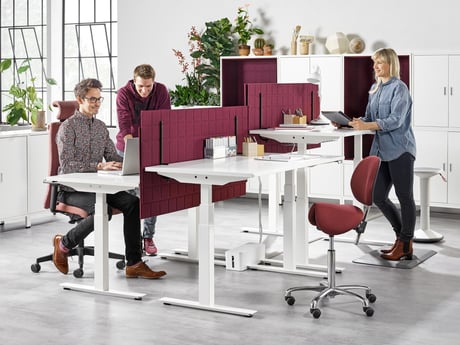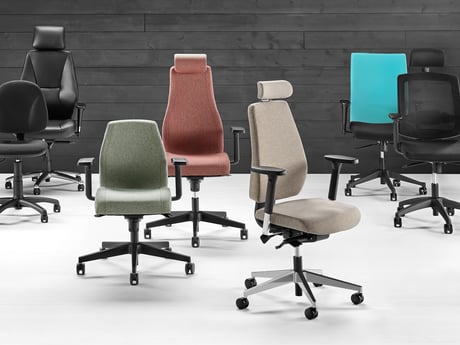
How to Use Magnetic and Mobile Whiteboards – Best Uses & Benefits
Whiteboards have revolutionised teaching, collaboration, and organisation, offering a cleaner and more efficient alternative to chalkboards. This guide explores the benefits of magnetic and mobile whiteboards, their applications, and how to choose the right one.

What Makes Magnetic Whiteboards Unique?
Magnetic whiteboards offer more than just a writable surface—they bring added convenience, organisation, and efficiency to any setting.
Unlike standard whiteboards, magnetic boards have a steel foundation beneath the dry-wipe surface. This allows users to attach documents, notes, and accessories using small magnets, making them perfect for presentations and collaborative work.
The smooth, non-porous surface ensures that dry-erase markers can be wiped off effortlessly, preventing stains and ghosting. Using magnetic accessories like pen holders and erasers reduces clutter and keeps essential tools within reach.
Traditional notice boards require pins, which can pose a hazard. Magnetic whiteboards eliminate the need for push pins, making them a safer choice for classrooms and offices.
Benefits of Mobile Whiteboards
Mobile whiteboards provide flexibility and convenience, making them ideal for dynamic workspaces.
Equipped with sturdy wheels, mobile whiteboards can be effortlessly moved between rooms, making them perfect for classrooms, boardrooms, and training sessions. Many models feature a double-sided design, allowing users to flip the board and continue writing without needing to erase.
For offices with limited wall space, mobile whiteboards provide a practical alternative to wall-mounted boards. Some models also offer adjustable height settings, making them suitable for users of all ages, from students to professionals.

Using Magnetic Whiteboards for Teaching and Learning
Magnetic whiteboards have become an essential tool in classrooms, replacing traditional chalkboards with a cleaner and more interactive solution.
Teachers can use these boards to write notes, illustrate concepts, and engage students in lessons. Magnetic accessories such as letters, numbers, and shapes provide a hands-on learning experience, especially for younger students.
Compared to chalkboards, whiteboards offer better visibility and readability, making it easier for students to follow along. They also require less maintenance, as dry-erase markers eliminate the dust and mess associated with chalk.
Students can actively participate by writing on the board or attaching materials with magnets, promoting engagement and collaboration in the classroom.

Using Magnetic Whiteboards for Business and Office Use
Magnetic whiteboards are widely used in office environments for meetings, brainstorming sessions, and presentations.
They serve as an effective tool for visualising ideas, mapping out strategies, and managing workflows. Teams can use magnets to pin important notes, schedules, and charts, creating an organised and collaborative workspace.
Many offices use whiteboards as notice boards to communicate important announcements without the need for push pins or staples. This makes updating information quick and efficient.
Modern offices also opt for frameless or glass whiteboards for a sleek, professional look that blends with contemporary office aesthetics.

Using Whiteboards for Decorative and Home Use
Beyond classrooms and offices, magnetic whiteboards can be a functional and decorative addition to homes.
In kitchens, they can serve as meal planners, to-do lists, or a space for family members to leave messages for one another. Many households also use them as display boards for artwork, photos, and travel souvenirs.
Creative professionals, such as designers and content creators, often use whiteboards for sketching ideas and organising tasks in their workspaces.
With a variety of colours, sizes, and patterns available, magnetic whiteboards can complement the interior design of both homes and offices.
How to Maintain and Clean Magnetic Whiteboards
Regular maintenance is key to keeping a whiteboard in top condition and ensuring a smooth writing experience. With proper care, whiteboards can remain stain-free and highly effective for years.
Follow these simple tips to clean and maintain your magnetic whiteboard:
- Use a dry microfibre cloth or a magnetic eraser to wipe off ink after each use.
- For deep cleaning, use a whiteboard cleaner or a mixture of water and mild soap.
- Avoid using permanent marker or ink-based pens, as they can leave stains.
- If ghosting occurs, apply a small amount of rubbing alcohol and wipe it clean.
- Store markers with the cap facing down to prevent them from drying out.
With proper care, a magnetic whiteboard will remain in excellent condition for years, providing a reliable surface for teaching, presentations, and planning.
Choosing the Right Whiteboard for Your Needs
With so many types of whiteboards available, choosing the right one depends on your workspace and requirements. Here’s a comparison of key whiteboard types:
CLICK TO VIEW WHITEBOARD COMPARISON
| Whiteboard Type | Best For | Key Benefits |
|---|---|---|
| Magnetic Whiteboard | Classrooms, offices, presentations | Allows use of magnets, easy to clean, widely used |
| Mobile Whiteboard | Flexible workspaces, training rooms | Portable, double-sided options, space-saving |
| Glass Whiteboard | Modern offices, high-end workspaces | Sleek design, durable, stain-resistant |
When choosing a whiteboard, consider:
- Space availability: Wall-mounted boards save space, while mobile options offer flexibility.
- Usage: Frequent use requires a durable surface, while occasional use may not need premium materials.
- Purpose: Teaching, brainstorming, or decorative use may influence the best choice.
Conclusion: Why Magnetic and Mobile Whiteboards Are a Smart Choice
Magnetic and mobile whiteboards have revolutionised the way we share ideas, organise information, and collaborate. Whether used in classrooms, offices, or homes, they provide a clean, efficient, and flexible solution for everyday needs.
From **interactive teaching tools** to **professional office planning**, whiteboards offer unmatched versatility. With easy maintenance and a variety of styles available, there’s a perfect whiteboard for every setting.
Explore our range of high-quality whiteboards and find the ideal solution for your workspace today!
Sources
- Abrahams, M. (2011) "Chalk: is it harmful to health?" The Guardian [Online] available from https://www.theguardian.com/education/2011/nov/28/chalk-dust-health-research [accessed October 2016]
The content of this page has been created by a partner with whom AJ Products is currently working. If you have any questions regarding the information on this page please do not hesitate to contact AJ Products (UK) Ltd.



